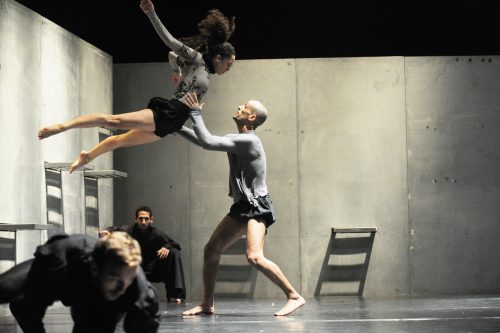
From Israel To Boston, The Vertigo Dance Company Takes The Shubert Stage. Lawrence Elizabeth Knox
“I never had this plan in my mind,” said choreographer Noa Wertheim, reflecting on her dreams as a young dancer at the start of her career. Yet a friendship with a fellow member of the Jerusalem Tamar Dance Company quickly developed into both an artistic and romantic collaboration, she explained in a Skype interview alongside her now-husband Adi Sha’al.
“We just wanted an excuse to meet in the studio. That’s the real story,” she said, both of them laughing. What began as a duet between her and Sha’al in 1992 has not only developed into one of Israel’s leading contemporary dance troupes, but a new way of life, a community of environmentally conscious artists.
This weekend (Oct. 29-30), 12 dancers in the Jerusalem-based Vertigo Dance Company will make their Boston debut, performing “Vertigo 20” at the Shubert Theatre as part of the Celebrity Series of Boston.
Created in 2012 in honor of the company’s 20th anniversary, “Vertigo 20” is a compilation of past works, a walk through history with pieces of choreography from the original duet to present repertoire. Through the creation process, however, “Vertigo 20” took a shape of its own. “Just the people who know the company very deep can recognize which [choreography] belongs to what,” said Sha’al, general manager and co-artistic director.
The piece is a celebration, Wertheim explained, but an element of contradiction adds an emotional depth to the theatricality of the work. The dancers are dressed as clowns, but the atmosphere remains sophisticated and heavy, she said, describing a poetic moment of 20 white balloons filling the stage.
“The question of choice, the game between heaven and earth bothers me a lot,” Wertheim said. “When you dig and find the nice place of the unknown, and you try to put it in a visual, physical way, it is art for me.” A philosophical uncertainty is apparent throughout her work, perhaps inspired by her strong connection to Kabbalah, a mystical Jewish philosophy. At one point, the dancers sit on shelves of metal. Their feet dangle over the edge, she explained, the space between them and the floor symbolizing that between our world and the world to come.
The music by Israeli composer Ran Bagno, the company’s musical director, only emphasizes the profoundness of the piece. “We see the flavor, the atmosphere the piece needs,” Wertheim said, “and then he decides the instruments and starts writing.” Incorporating music after she begins the choreographic process might seem unconventional, but neither Wertheim nor Sha’al have followed a traditional path.
Both of their careers began late — around the age of 21. “Noa because she’s coming from a religious background, and it was not considered modest enough,” Sha’al said. “Me personally, dance was not for men in this country.”
However, after completing Israel’s mandatory military service (two years for women and three years for men) and volunteering an extra year, the artists found their way to dance. Their original duet, “Vertigo,” stems from Sha’al’s firsthand experience as a pilot in the air force. “We took this feeling of dizziness, or vertigo,” Sha’al said, “and we projected it from the world of flying into dance, into relationships.”
In a way, relationships lie at the root of the couple’s work. Nine years ago, Wertheim and her three sisters created Eco-Art Village, an eco-friendly, tribal community that unites individuals of diverse populations, those with different religions, cultures, abilities, and more. The sisters live together with their families (Wertheim and Sha’al have 3 boys) at the Village, which overlooks the Valley of Elah, where David once defeated Goliath.
“We are focusing quite a lot on three pillars, which is art, human, and nature,” Sha’al said. “I think what is unique about Vertigo is this holistic way of thinking.”
The Village is not the first time Vertigo Dance Company has explored social innovations. In 2001, the troupe performed “The Power of Balance” by choreographer Adam Benjamin, a work that unites company members and physically challenged individuals onstage. Due to the show’s success, the company developed an integrated dance program by the same name.
Another branch of Vertigo is its International Dance Program, where students from around the world, ages 18-25, study Wertheim’s style of contemporary movement called the “Language of Vertigo.” Offering more than dance training, the program also encompasses the ideology of the company, and the artists live where they work — at the Eco-Art Village.
This way of life, a life of artistry, collaboration, sustainability and community, is what the couple aspires to share with audiences around the world. “It’s very real for myself, this family oneness,” Wertheim said. “The life and the art is one. I don’t separate it. I go to the studio, and it’s part of my life, part of my family.”
